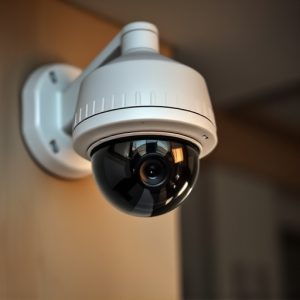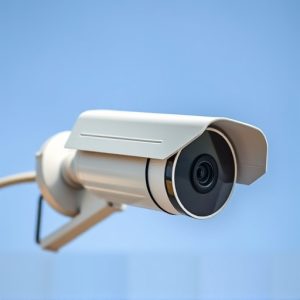Realistic Fake Surveillance: Mounting Dummy Cameras Under Eaves for Security
In today's digital era, mounting dummy cameras under eaves offers a subtle yet powerful solutio…….
In today's digital era, mounting dummy cameras under eaves offers a subtle yet powerful solution for enhanced security without compromising privacy. By strategically placing realistic camera replicas in discreet locations, property owners and businesses can deter petty crimes while maintaining low visibility. This method, especially valuable in high-risk areas, disrupts common burglary patterns by mimicking active surveillance without the need for extensive retrofitting or constant monitoring. However, it raises critical legal and ethical concerns regarding privacy rights, requiring a delicate equilibrium between security needs and individual privacy protection.
In today’s digital age, enhancing security while maintaining privacy is a constant challenge. Realistic-looking fake surveillance equipment, or decoy cameras, offer an innovative solution. This article explores the growing need for these devices, providing a comprehensive guide on mounting dummy cameras, particularly under eaves, and highlighting their benefits. We also delve into legal and ethical considerations to ensure responsible use, navigating privacy laws with these security enhancements.
- Understanding the Need for Realistic Fake Surveillance Equipment
- Mounting Dummy Cameras: A Step-by-Step Guide
- Benefits of Using Under-Eave Installations for Security Deception
- Legal and Ethical Considerations: Navigating Privacy Laws with Decoy Cameras
Understanding the Need for Realistic Fake Surveillance Equipment
In today’s digital age, where surveillance is increasingly prevalent, there exists a growing demand for realistic fake surveillance equipment. While genuine security cameras are effective, they often expose their presence, potentially deterring crime or compromising privacy. This is where mounting dummy cameras under eaves comes into play—a subtle yet powerful solution. By installing lifelike replicas of real cameras in discreet locations, property owners and businesses can create the illusion of enhanced security without sacrificing aesthetics or privacy.
This strategy is particularly valuable for deterring petty crimes like theft or vandalism. Realistic fake surveillance equipment provides a psychological barrier, convincing potential perpetrators that they are under constant observation. Moreover, it serves as an effective deterrent in high-risk areas, such as retail stores, residential neighborhoods, and industrial sites, where maintaining a low profile while ensuring safety is paramount.
Mounting Dummy Cameras: A Step-by-Step Guide
Creating a realistic security setup with fake surveillance equipment involves meticulous planning, especially when it comes to mounting dummy cameras. The strategic placement of these mimicry devices can significantly enhance the overall authenticity of your faux security system. One effective method is to mount them under eaves—a technique that adds a layer of realism and discretion. Here’s a step-by-step guide to help you achieve this:
1. Select Suitable Dummy Cameras: Choose high-quality, realistic-looking dummy cameras designed specifically for such purposes. Ensure they closely mimic real security cameras in terms of size, shape, and features like LED indicators and lenses.
2. Measure and Plan: Before mounting, carefully measure the length of your eaves to determine how many cameras you can accommodate without creating an unsightly arrangement. Use a level to ensure proper alignment and a pencil to mark spots where you plan to secure each camera.
3. Secure Mounting Brackets: Attach suitable mounting brackets under the eaves. These should be designed for outdoor use, weatherproof, and strong enough to bear the weight of the cameras. Ensure they’re securely fastened to solid structural elements using appropriate hardware.
4. Position Cameras: Carefully position each dummy camera on its designated bracket, ensuring it aligns with your initial planning. Adjust as needed to maintain a natural, non-obtrusive look.
5. Connect Wiring (if applicable): Some models may have wires that need to be discreetly run and connected to a power source or a fake control panel. Ensure the wiring is hidden from view, enhancing the realism of your setup.
Benefits of Using Under-Eave Installations for Security Deception
Mounting dummy cameras under eaves is a strategic approach to enhancing security deception, offering several key advantages for homeowners and businesses alike. This method involves discreetly installing realistic-looking surveillance equipment in the shadowed areas beneath roof overhangs, providing an effective deterrent against potential intruders. The primary benefit lies in its ability to create a false sense of visibility, as these under-eave installations mimic the presence of active cameras while remaining hidden from view.
By strategically placing dummy cameras in such locations, security measures are amplified, encouraging would-be criminals to proceed with caution. This tactic disrupts common burglary patterns, as intruders often seek areas of cover and concealment. Additionally, these devices can be easily maintained and provide a cost-effective solution for enhancing overall security without the need for extensive retrofitting or constant monitoring.
Legal and Ethical Considerations: Navigating Privacy Laws with Decoy Cameras
The widespread adoption of realistic-looking fake surveillance equipment, including dummy cameras, raises significant legal and ethical questions, particularly concerning privacy rights. As technology advances, mounting dummy cameras under eaves or in concealed locations becomes increasingly feasible, blurring the line between security measures and invasive monitoring. This practice must adhere to stringent privacy laws designed to protect individuals from unwarranted surveillance.
In many jurisdictions, placing hidden cameras without consent is a breach of privacy legislation. Navigating these legalities requires careful consideration of when and where dummy cameras can be ethically deployed. Property owners or businesses installing such equipment should ensure compliance with relevant regulations, often involving obtaining explicit permission from occupants or adhering to specific guidelines for public spaces. Ethical deployment involves striking a balance between security needs and respecting personal privacy, ensuring that the use of fake surveillance is transparent and justifiable.
Realistic fake surveillance equipment, particularly under-eave installations of mounting dummy cameras, offers a subtle yet powerful deterrent for potential intruders. By employing these deceptively authentic-looking devices, homeowners and businesses can significantly enhance their security without compromising privacy. Following best practices outlined in this article—from understanding the legal landscape to implementing effective placement strategies—ensures that you harness the full benefits of realistic fake surveillance, creating a safer environment while respecting privacy rights.


